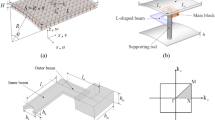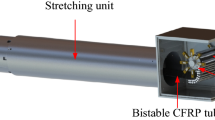Abstract
A solar power sail demonstrator “IKAROS” demonstrated solar sailing technology in 2010. The membrane of the spinning solar sail IKAROS is estimated to be deformed toward the Sun. The deformation was kept even under low spin-rate. Previous studies suggest that curvature of thin-film solar cells on the membrane increases the out-of-plane stiffness by finite element analysis. Shape, out-of-plane stiffness, and natural frequency of membranes have to be predicted for solar sails with thin-film devices, such as thin-film solar cells, dust counters, and reflectivity control devices in order to reduce the margins of sail size and propellant mass against disturbance solar pressure torque acting on the membrane. In this paper, the effect of a curved thin-film device on the natural frequency of a rectangle membrane under uniaxial tension was investigated. Three types of membranes were evaluated: a membrane with a curved thin-film device, a membrane with a flat thin-film device, and a plane membrane. Geometric nonlinear finite element analysis and eigenvalue analysis were conducted to investigate the natural frequencies under varying tension. The simulations were verified by vibration experiments. It was found that under low tension, the natural frequency of the membrane with the curved thin-film device is significantly higher than that of the others and that under high tension, the natural frequency of the membrane with the thin-film device is slightly lower than that of the plane membrane. In addition, parametric analysis on the curvature of the thin-film device shows that natural frequency at low tension is sensitive to the curvature. The eigenvalue analysis of a whole solar sail with the curved thin-film devices also suggests that the curvature remarkably affects the vibration modes. In conclusion, curved thin-film devices have a significant impact on the out-of-plane stiffness of a membrane under low tension.
Similar content being viewed by others
Change history
11 February 2022
A Correction to this paper has been published: https://doi.org/10.1007/s42064-022-0136-2
Abbreviations
- f :
-
natural frequency (Hz)
- f i :
-
natural frequency of mode number i (Hz)
- i :
-
mode number
- k :
-
spring constant (N/m)
- l :
-
length (m)
- m :
-
mass (kg)
- A :
-
area (m2)
- E :
-
Young’s modulus (Pa)
- F :
-
tension (N)
- I :
-
second moment of area (m4)
- M :
-
moment of force (N·m)
- R :
-
curvature radius (mm)
- ρ :
-
density (g/cm3)
References
Mori, O., Shirasawa, Y., Mimasu, Y., Tsuda, Y., Sawada, H., Saiki, T., Yamamoto, T., Yonekura, K., Hoshino, H., Kawaguchi, J. Funase, R. Overview of IKAROS mission. In: Advances in Solar Sailing. Malcolm, M., Ed. Berlin, Heidelberg: Springer Berlin Heidelberg, 2014: 25–43.
Sawada, H., Mori, O., Shirasawa, Y., Kitamura, K., Chishiki, Y., Matunaga, S., Nishihara, T. Shape estimation of IKAROS’s solar power sail by images of monitor cameras. In: Proceedings of the 53rd AIAA/ASME/ASCE/AHS/ASC Structures, Structural Dynamics and Materials Conference, 2012: AIAA 2012-1749.
Okuizumi, N., Satou, Y., Mori, O., Sakamoto, H., Furuya, H. Investigation of the deformation and stiffness of spinning solar sail membrane of IKAROS. In: Proceedings of the 4th AIAA Spacecraft Structures Conference, 2017: AIAA 2017-1113.
Satou, Y., Mori, O., Okuizumi, N., Shirasawa, Y., Furuya, H., Sakamoto, H. Deformation properties of solar sail IKAROS membrane with nonlinear finite element analyses. In: Proceedings of the 2nd AIAA Spacecraft Structures Conference, 2015: AIAA 2015-0436.
Tsuda, Y., Mori, O., Funase, R., Sawada, H., Yamamoto, T., Saiki, T., Endo, T., Yonekura, K., Hoshino, H., Kawaguchi, J. Achievement of IKAROS— Japanese deep space solar sail demonstration mission. Acta Astronautica, 2013, 82(2): 183–188.
Wong, Y., Pellegrino, S., Park, K. Prediction of winkle amplitudes in square solar sails. In: Proceedings of the 44th AIAA/ASME/ASCE/AHS/ASC Structures, Structural Dynamics, and Materials Conference, 2003: AIAA 2003-1982.
Jenkins, C. H. M., Korde, U. A. Membrane vibration experiments: An historical review and recent results. Journal of Sound and Vibration, 2006, 295(3-5): 602–613.
Singhal, R. K., Gorman, D. J., Crawford, J. M., Graham, W. B. Investigation of the free vibration of a rectangular membrane. AIAA Journal, 1994, 32(12): 2456–2461.
Nishizawa, T., Sakamoto, H., Okuma, M., Furuya, H., Sato, Y., Okuizumi, N., Shirasawa, Y., Mori, O. Evaluation of crease effects on out-of-plane stiffness of solar sails. Transactions of the Japan Society for Aeronautical and Space Sciences, Aerospace Technology Japan, 2014, 12(ists29): Pc_107-Pc_113.
Okuizumi, N. Effect of creases on the stiffness of spinning circular membrane. Transactions of the Japan Society for Aeronautical and Space Sciences, 2018, 61(6): 274–280.
Matsushita, M., Okuizumi, N., Sato, Y., Mori, O., Iwasa, T., Matunaga, S. Effect of curved thin-film device on natural frequency of rectangle membrane under uniaxial tension. Aerospace Technology Japan, the Japan Society for Aeronautical and Space Sciences, 2019, 18: 73–80. (in Japanese)
Cerda, E., Ravi-Chandar, K., Mahadevan, L. Wrinkling of an elastic sheet under tension. Nature, 2002, 419(6907): 579–580.
Tatematsu, Y., Suzuki, T., Yamazaki, M., Miyazaki, Y. Verification of the similarity rules for spin deployment membrane in the ground experiment. In: Proceedings of the 4th AIAA Spacecraft Structures Conference, 2017: AIAA 2017-1114.
Tessler, A., Sleight, D. W., Wang, J. T. Effective modeling and nonlinear shell analysis of thin membranes exhibiting structural wrinkling. Journal of Spacecraft and Rockets, 2005, 42(2): 287–298.
Iwasa, T., Natori, M. C, Noguchi, H., Higuchi, K. Geometrically nonlinear analysis on wrinkling phenomena of a circular membrane. Research Report on Membrane Structures, 2002, 16: 7–14. (in Japanese)
Matsushita, M., Mori, O., Okuizumi, N., Satou, Y., Iwasa, T., Matunaga, S. Wrinkling of a membrane with a curved small thin film. Transactions of the Japan Society for Aeronautical and Space Sciences, Aerospace Technology Japan, 2018, 16(6): 500–505.
Information on http://dsk.ippt.pan.pl/docs/abaqus/v6.13/index.html (cited 7 Jan 2019).
Yamagiwa, I., Utsuno, H., Endo, K., Sugii, K. Identification of flexural rigidity and tension of the one-dimensional structure by measuring eigenvalues in higher order. Transactions of the Japan Society of Mechanical Engineers Series G, 2000, 66(649): 2905–2911. (in Japanese)
Acknowledgements
This work was supported by JSPS KAKENHI Grant Number 17H01349 and the ISAS/JAXA solar power sail preparation team.
Author information
Authors and Affiliations
Corresponding author
Additional information
Masanori Matsushita is a research and development staff in the ISAS/JAXA. He works on the OKEANOS solar power sail and is mainly in charge of the sail membrane structure. He received his M.S. and Ph.D. degrees of engineering from Tokyo Institute of Technology, in 2014 and 2018, respectively. He joined the TSUBAME micro-satellite mission, which was launched in 2014, and contributed to research and development of electrical power system from 2009 to 2014. His research interests are space membrane structures, electrical power systems, CubeSats, and micro-satellites.
Nobukatsu Okuizumi received his bachelor, master, and Ph.D. degrees in mechanical engineering from Tokyo Institute of Technology in 1989, 1991, and 1998, respectively. He is an assistant professor at the Institute of Space and Astronautical Science, Japan Aerospace Exploration Agency. His research interests include lightweight deployable structures, spacecraft structures, and nonlinear dynamics of mechanical and structural systems. He has also been engaged in the development of various scientific spacecrafts such as Akatsuki, IKAROS, Hayausa2, etc.
Yasutaka Satou received his doctor degree in engineering from Department of Built Environment, Tokyo Institute of Technology, in 2012. Currently, he is an assistant professor in Department of Space Flight Systems, ISAS/JAXA.
Osamu Mori received his Ph.D. degree in engineering from Tokyo Institute of Technology, Japan, in 2002. He is currently an assistant professor at Institute of Space and Astronautical Science, Japan Aerospace Exploration Agency. His research includes spacecraft systems, multibody dynamics, guidance, navigation and control. He is a project manager of the IKAROS mission and a core member of the OKEANOS mission.
Takashi Iwasa is an associate professor at the Department of Mechanical and Aerospace Engineering in Tottori University. He received his B.E degree in structure engineering from Nagasaki University, M.E. degree in civil engineering from University of Tokyo, and doctor degree in engineering in aeronautics and astronautics engineering from University of Tokyo. His current research interests include gossamer space structure, precise-large space structure, structural mechanics, finite element analysis, and photogrammetric measurement.
Saburo Matunaga is a professor at the Department of Mechanical Engineering in Tokyo Institute of Technology. He received his B.E degree in aerospace engineering from Nagoya University, M.E. and doctor degrees in engineering in astronautics from the University of Tokyo. His current research interests include nano/microsatellite development, launch and operation, and advanced space systems engineering.
Rights and permissions
About this article
Cite this article
Matsushita, M., Okuizumi, N., Satou, Y. et al. Influence of thin-film device with curvature on natural frequency of rectangle membrane under uniaxial tension. Astrodyn 3, 257–272 (2019). https://doi.org/10.1007/s42064-019-0056-y
Received:
Accepted:
Published:
Issue Date:
DOI: https://doi.org/10.1007/s42064-019-0056-y




